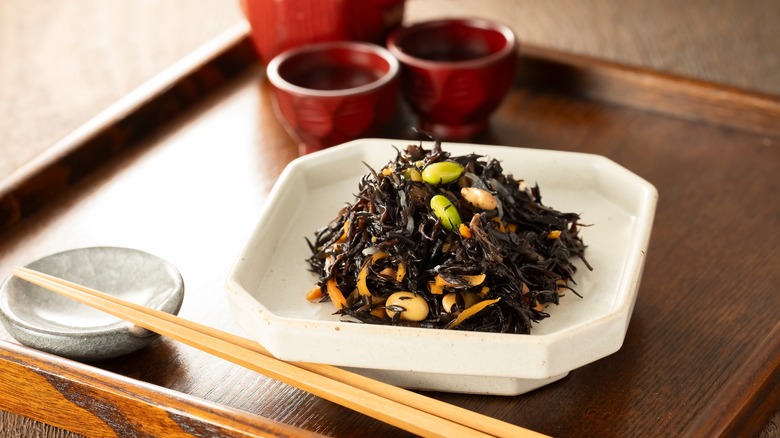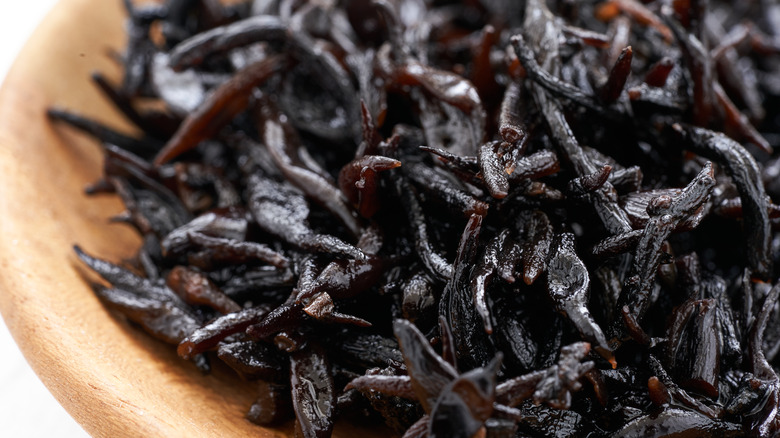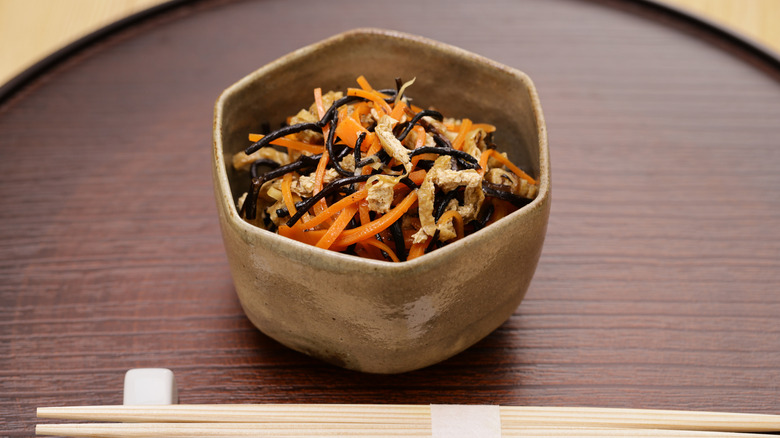What Is Hijiki Salad (And Is It Safe To Eat)?
Seaweed is consumed around the globe, and it's particularly known as an integral part of Japanese cuisine. But seaweed isn't simply "seaweed"; there are numerous varieties and each serve different purposes. Nori is the binder that holds sushi rolls together (and it makes a great gluten-free option for sushi burritos), while kombu is the key ingredient in dashi, Japan's unique variety of stock. And when you hear "Japanese seaweed salad," the green noodle-like variety you're probably thinking of is wakame. Then there's hijiki, found on rocky coastlines in parts of East Asia, and noted for its chewy consistency and distinct black, twisty, slightly stringy appearance.
While hijiki shows up in Chinese and Korean cuisine as well, it's most associated with Japanese food (the word "hijiki" is itself Japanese) in the form of hijiki salad. Though there isn't one agreed-upon recipe for hijiki salad, it often includes edamame, carrots, and a sweet seasoning, with hijiki as the base.
Unfortunately, there's one drawback to hijiki. According to the National Institute of Health, it has a tendency to soak up and store inorganic arsenic from the environment around it. This is a problem, considering inorganic arsenic is a carcinogen, as the American Cancer Society notes. As a result, most health agencies think consumers should avoid hijiki (though not the other ingredients in hijiki salad). How stringent consumers are advised to be about it varies by country, though.
Long-term inorganic arsenic exposure can be dangerous
Arsenic is more prevalent in seafood than you might realize, it's just that most of it is the organic variety. Organic arsenic in fish and shellfish is not particularly toxic. Inorganic arsenic, however, is where the element gets its bad reputation. The World Health Organization notes that inorganic arsenic is highly toxic and linked to conditions such as skin lesions and cancer, as well as cognitive developmental issues among children.
While most varieties of seaweed contain arsenic, it's generally the organic variety. Hijiki, though, has an unfortunate tendency to absorb the inorganic variety from seawater and hold onto it. It isn't going to be enough to poison you to death on the spot, but the theory is that repeated exposure could lead to those long-term negative health effects. It's for this reason that the governments of both Canada and the United States have recommended against the consumption of hijiki. The European Food Safety Authority has likewise made recommendations for reducing how much hijiki Europe's citizens eat, and is even considering additional regulations.
There's a way to reduce hijiki's arsenic content
But how dangerous is it, really? We don't actually know for sure. Though studies do show high levels of inorganic arsenic in hijiki, there aren't any studies that have directly linked hijiki itself to cancer (the Canadian government even noted as much in their statement). But there are certainly studies that link inorganic arsenic to cancer generally.
While some nations recommend against consuming it, multiple East Asian countries such as Singapore and Japan do not advise eliminating hijiki from consumers' diets entirely. Rather, they suggest eating it in moderation, the same way you shouldn't eat too much salmon because it contains mercury. The Center for Food Safety in Hong Kong, for example, noted that the "occasional consumption of small amount of hijiki is unlikely to cause adverse health effect" (although they still advised against eating it).
It's also important to note there are ways consumers can themselves reduce the dangers from hijiki. In addition to not eating too much of it and buying from trusted retailers, soaking it prior to consumption can help. If you soak hijiki in boiling water and salt for around 20 minutes, it reduces the seaweed's arsenic content by about 33% to 80%. Just discard the water immediately, because cooking with or drinking it would defeat the entire purpose.


